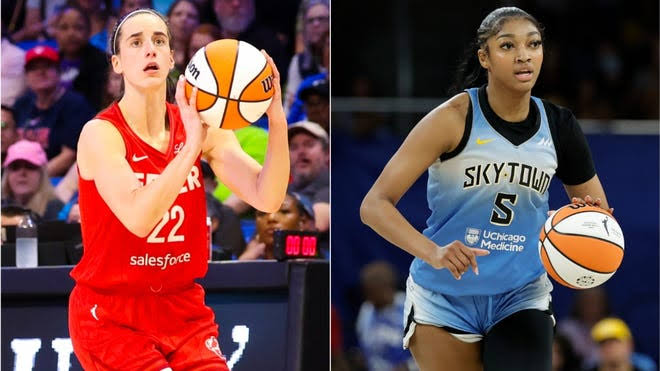Throughout the season, Angel Reese and Caitlin Clark have faced criticism for a variety of reasons, one of the most notable being accusations of stat-padding during blowouts. These claims have sparked debate among fans and analysts, questioning whether these rookie stars are inflating their statistics in non-competitive situations.
Caitlin Clark was called out earlier in the year for allegedly chasing a franchise assist record during a blowout game for the Indiana Fever. Similarly, Angel Reese has been criticized for pursuing double-doubles late in games, particularly when the outcome was already decided. This controversy came to a head when Reese secured her rookie record-setting 23rd double-double during the closing moments of a lopsided loss to the Fever—a game in which Clark had already exited.
But how much merit do these accusations hold? Let’s dive into the data to evaluate the validity of these claims.
Caitlin Clark vs. Angel Reese: Are They Stat-Padding?
The concept of stat-padding is subjective, often influenced by individual perceptions of what constitutes a “blowout.” For this analysis, we examined every possession within the last three minutes of games where one team led by 10 points or more, to see how often Reese and Clark were accumulating stats in what could be considered garbage time.
Both Clark and Reese have played over 2,000 possessions this season, with only a minuscule fraction occurring during garbage time. During these minutes, neither player has significantly padded their stats. In fact, their overall season statistics remain consistent even when excluding garbage time performances, suggesting that these accusations may be overblown.
For those who have been watching their games closely, the criticisms, especially against Clark, seem unfounded. Clark is often seen dribbling out the clock during the end of quarters or blowouts, rather than padding her stats with unnecessary shots.
While the criticisms against Reese do have a small basis, they are largely exaggerated. Here are the specific examples critics often highlight:
- July 10: Reese was fouled with six seconds left, extending her double-double streak to 14 by making both free throws, despite the Chicago Sky facing a seven-point deficit.
- July 11: Reese secured her 15th consecutive double-double with two minutes remaining, while the Sky were down by 11 points.
- July 13: Reese was accused of attempting to chase another double-double on the final possession of a 14-point loss, but was forced to pass out of a quadruple team by the Liberty, ending her streak at 15.
- August 30: Reese’s double-double came with 2:41 left and the Sky down by 24 points, a game in which Clark had checked out more than a minute earlier.
These instances represent only three of Reese’s 25 double-doubles, suggesting that the vast majority of her accomplishments occurred in competitive situations. Even if these three games are considered, Reese would still have achieved double-doubles in two-thirds of her rookie games and set a record for consecutive double-doubles.
Despite the attention these instances have received, such occurrences are common across all professional leagues and are often less egregious than other examples, such as NBA star Domantas Sabonis’s controversial methods to extend his double-double streak.
Additionally, the narrative surrounding Reese’s alleged stat-padding looks even weaker when considering her play in garbage time. Reese has scored just one field goal all season when her team was down by more than 10 points with under three minutes left. This lone basket, during a highly-publicized game, has unfairly fueled her critics.
Reese has also faced accusations that her rebounding totals are inflated by grabbing her own misses. However, data disproves this claim—she remains one of the greatest rebounders in the league, even when excluding rebounds from her own shots.
The Bigger Picture: Development and Clutch Performance
What’s actually true about Reese and Clark is that both are outstanding young players who significantly impact their teams. Given their youth, they are often on the court during late-game situations, even in losses, to continue developing their skills. This results in them playing many minutes—both rank in the top 15 in the league—even in games that are out of reach.
This can lead to situations such as Clark playing the final 18 minutes of a 19-point loss to the Aces or Reese staying in the entire fourth quarter of a 19-point loss to the Fever. However, it’s important to note that they also play nearly all of their teams’ clutch minutes, a fact often overlooked in the stat-padding debate.
Both players rank in the top 20 in clutch points scored this season, despite being on teams that are not among the league’s elite. Clark leads the league in clutch assists, while Reese dominates in clutch rebounds. Their ability to elevate their play in crucial moments, shooting close to 90% on clutch free throws (Clark is 24-of-27, while Reese is 10-of-11), underscores their fearlessness in big moments.
In conclusion, while there are a few isolated examples of Reese extending her double-double streak in blowouts, and one baseless accusation against Clark, the vast majority of their seasons have been marked by exceptional play when it matters most. Accusations of stat-padding against them are not only a disservice to their achievements but are also unsupported by the actual game data. Both players are deserving of the accolades they’ve received, and attempts to diminish their accomplishments ring hollow.
